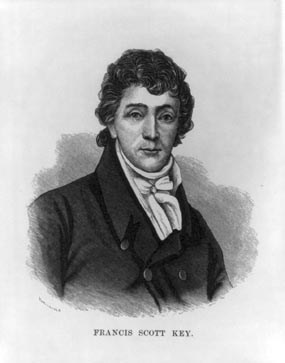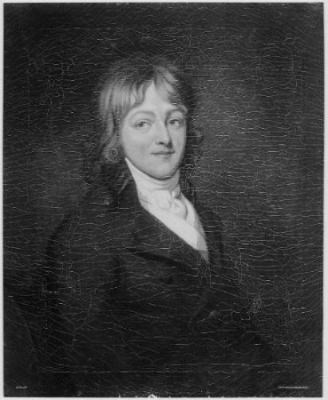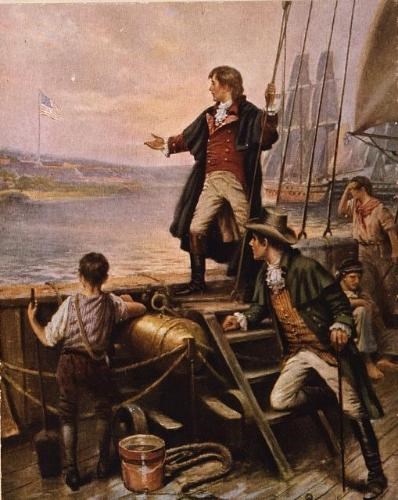
Library of Congress Francis Scott Key stood aboard the deck of an American truce ship on September 14, 1814 and watched the raising of Fort McHenry’s large garrison flag over the ramparts. He had witnessed Britain’s twenty-five hour bombardment of the Fort, and for Key, the raising of the American flag was a triumphant symbol of bravery and perseverance. This image inspired Key to write about what he had seen. In four stanzas, Key wrote “The Defense of Fort M’Henry.” The words spread like wildfire throughout the young nation. It became “The Star Spangled Banner” and was soon a national air like “Yankee Doodle” and “Hail Columbia.” In 1931, Key’s song was designated as the national anthem of the United States. Early LifeFrancis Scott Key was born on August 1, 1779 in Frederick County, Maryland. He was raised by a wealthy family on a plantation supported by enslaved labor called Terra Rubra (“red earth”). Members of the Key family practiced law, became elected officials, and fought both for and against the British during the American Revolution. Francis Scott Key, or “Frankie”, was particularly close to his sister Anne Phoebe Charlton Key. Key looked back on his childhood fondly, and wrote a poem entitled “To My Sister” in which he reflects on the “bright hours” he spent with her on the family plantation. 
Library of Congress Key moved to Annapolis in 1789 to attend preparatory school at St. John’s College, where he studied Latin, Greek, mathematics, grammar, and the sciences. Key graduated from St. John’s and studied law under his uncle Philip Barton Key in 1796. In 1802, Key married into a prominent Maryland slave holding family, which would further complicate his relationship with slavery (see below). Key and his wife, Mary Tayloe “Polly” Lloyd, settled in Georgetown, where Key practiced law. He and Polly started a family, and they would eventually have eleven children. Key’s father was forced to auction off Terra Rubra by economic hardship, and Key took out a substantial loan to purchase the property for $8,500.00 in 1811. A struggle for financial stability drove Key away from serving in the ministry, which he had considered when he was a young lawyer. Key was a devout Episcopalian and took an active role in the activities of multiple Episcopalian churches. CareerFrancis Scott Key was a prominent lawyer in Frederick, Maryland and Washington, D.C. He made his name in 1807 defending Justus Eric Bollman and Samuel Swartwout who had been charged with treason in connection to an alleged conspiracy designed by Aaron Burr. Key served as an advisor to Andrew Jackson and served as the District Attorney for the District of Columbia from 1833 to 1841. 
Library of Congress War of 1812Key opposed the War of 1812 but served as a quartermaster in the Georgetown Artillery against the British. Key served as a volunteer aide to General Walter Smith at the Battle of Bladensburg in August of 1814. Key relayed tactical information and reportedly served to inform artillery positions based on his knowledge of the area. The Battle of Bladensburg was an embarrassing defeat for the United States and it allowed British forces to enter and take the capital city. One of Key’s most notable professional achievements was aiding John Skinner in negotiating for the release of Dr. William Beanes, a prominent Upper Marlboro physician who had been captured by the British prior to the Battle of Baltimore. It has during this undertaking that Key penned “The Defense of Fort M’Henry,” which became “The Star-Spangled Banner” and later the national anthem in 1931. Francis Scott Key and SlaveryFrancis Scott Key had a conflicted relationship with slavery. Key defended enslaved individuals seeking their freedom as an attorney and believed that “by the law of nature all men are free. The presumption that even Black men and Africans are slaves is not a universal presumption.” 
NPS/Harpers Ferry Center He defended other slave owners seeking to regain runaway “property” in several cases as an attorney. Key vehemently opposed abolition and favored the idea of colonization, helping to establish the American Colonization Society in 1816. Key manumitted, or freed, several slaves. He signed a manumission for two enslaved boys named Joe and John, who were two years and six months of age, but stipulated that they would not be manumitted until they “attained the age of 25 years.” "The Star Spangled Banner" and SlaveryBoth the Star Spangled Banner and the eponymous song written have connections with the institution of slavery. Francis Scott Key defended and participated in the institution of slavery, and his personal ownership of enslaved people stands opposed to his definition of the United States as “the land of the free.” The third verse of the song mentions that “No refuge could save the hireling and slave.” It is not clear what Key intended this line to mean, and he could have been referring to the foreign troops serving with the British, or perhaps the escaped enslaved men that comprised the British Colonial Marines. DeathKey practiced law until just before his death of pleurisy on January 11, 1843. Key is buried at Mount Olivet Cemetery in Frederick, Maryland. |
Last updated: July 16, 2025
